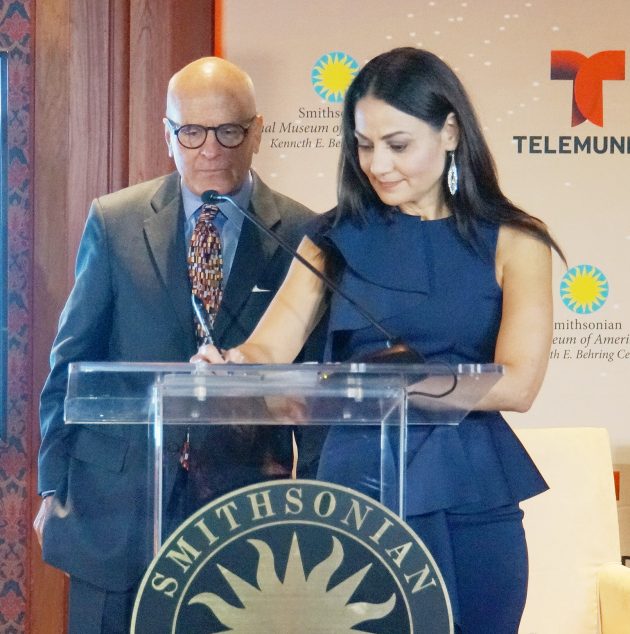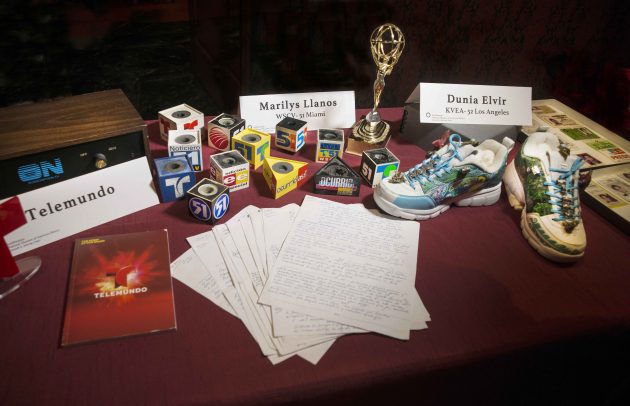Maria Anderson

This series of microphone cubes used over the years by Telemundo 51 WSCV-TV in Florida was donated by Marilys Llanos, senior political reporter at at the station. (Photo by Laura Duff)
The history of Spanish-language television in the U.S. spans more than 70 years. It began in the 1940s and 1950s with local radio and TV stations that transformed themselves into a nationwide network of affiliates, providing much-needed news and programming to the nation’s Latino community.
Telemundo—a historic Spanish-language TV network in the U.S.—recently donated objects and documents to the Smithsonian’s National Museum of American History, as part of the museum’s effort to document the rich history of Spanish-language broadcasting.
The donation, which is part of the museum’s “Escuchame: The History of Spanish-Language Broadcasting in the U.S.” initiative, recognizes the contributions to U.S. Spanish-language broadcasting history from the network and its local stations: KVEA-TV, Los Angeles; WSCV-TV, Miami-Fort Lauderdale; WNJU-TV, New York; and Puerto Rico’s WKAQ-TV.

John Gray, National Museum of American History director, looks on as Mónica Gil, executive vice president of corporate affairs of NBC Universal Telemundo Enterprises, signs a donation agreement during the ceremony. (Photo by Laura Duff)
More than 40 current and former Telemundo employees contributed by participating in oral history interviews or contributing to the collection of objects that reflect the material culture of broadcasting.
“By documenting the contributions of Spanish-language broadcasters and how they influenced the national narrative, this collection and its companion oral histories will change the way the history of American television is written,” said Kathleen Franz, the museum’s curator of American business history and chair of the Division of Work and Industry.

Items donated by Marilys Llanos, senior political reporter at Telemundo 51, WSCV-TV in Miami, and anchor Dunia Elvir from Telemundo 52 KVEA-TV Los Angeles. (Photo by Laura Duff)
Among the donated objects are two costumes from “Tanairi,” a famous telenovela produced by Telemundo Puerto Rico, WKAQ-TV. The station was founded by “El Mundo” newspaper owner Angel Ramos in San Juan, Puerto Rico, in 1954, and is one of the primary industry pioneers in the development of Spanish-language programming in the U.S. WKAQ-TV’s popularity in Puerto Rico, combined with the increased need for Spanish-language programing in the U.S., led investors to take a chance on building more Spanish-language stations and networks.
The donation also includes more than 30 press credentials reflecting “Noticiero Telemundo” anchor José Diaz-Balart’s journalism career. There are scripts, photographs, microphone cubes and a Florida Emmy Award that capture the work of Marilys Llanos, senior political reporter at Telemundo 51, WSCV-TV, and a pair of painted tennis shoes illustrated with personal and career highlights from Telemundo 52 KVEA-TV anchor Dunia Elvir. A suit coat, pocket squares and glasses represent Telemundo 47 WNJU-TV journalist Hector Aguilar’s on-air presence at the station and his life-long career in Spanish-language radio and TV.

Noticiero Telemundo anchor José Diaz-Balart, right, and American History Museum historian Mireya Loza, display some of the 30 press credentials donated by Diaz-Balart to the museum. (Photo by John Barrat)
“We tell stories in the museum through objects,” says Mireya Loza, curator in the museum’s Division of Work and Industry. “Without the objects, we can’t really talk about history because there’s nothing to put in a case.”
“These press credentials represent part of the journey, in 1984, when Spanish-language network television was really just starting and I was fortunate enough to be part of that,” said Diaz-Balart, who began his career with the former Spanish International Network (SIN). “Those IDs are moments that will forever mean much more than a piece of paper. They, in a very real way, define Spanish-language television as it is today.”
Telemundo is currently owned by Comcast through NBCUniversal. The network is headquartered in Miami and owns 18 television stations across the country. The local stations have worked for years to build their reputations as trusted news sources in their communities, which is why the museum focused its collecting initiative with the local stations as well as the network.

Attending the Telemundo donation ceremony at the American History Museum were, from left, Noticiero Telemundo anchor José Diaz-Balart; Marilys Llanos, senior political reporter at Telemundo 51 WSCV-TV Miami; American History Museum Director John Gray; Mónica Gil, executive vice president corporate affairs, NBC Universal Telemundo Enterprises; and Allan Villafaña, presenter at Noticiero 47 Telemundo Primera Edición. (Photo by John Barrat)
In addition to the objects donated, 38 audio interviews were conducted with Telemundo anchors, reporters, engineers, traffic directors, camera operators, art directors, and sales and marketing staff. These oral histories, which reside in the museum’s Archives Center, are accessible to scholars and researchers.
“We’re very excited about the work that we’re doing and that we’ll be able to preserve this history for generations to come,” Loza said.





